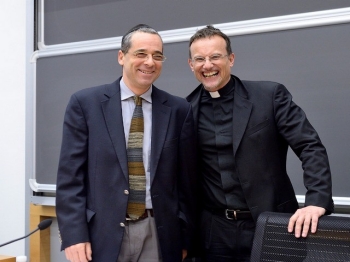Christians and Jews today: “Encounter must be face to face”
 Rabbi David Meyer and his friend, the Jesuit Father Philipp Gabriel Renczes, director of the Cardinal Bea Center for Judaic Studies at the Pontifical Gregorian University in Rome.
Rabbi David Meyer and his friend, the Jesuit Father Philipp Gabriel Renczes, director of the Cardinal Bea Center for Judaic Studies at the Pontifical Gregorian University in Rome.
Interview with Belgian Rabbi David Meyer, lecturer at the “Cardinal Bea” Center for Judaic Studies at the Pontifical Gregorian University. Rabbi Meyer has taught in various countries, from Belgium to Peru, from China to Italy. In this interview he tells us about the approach to the other in Jewish tradition and the complexity of interreligious dialogue in the Holy Land in addition to his personal experience of dialogue.
Going back to the sources of Jewish tradition like the Talmud, what is the place historically given to those who are not part of the people of Israel within the Jewish community?
Traditionally if you go back to classical rabbinic texts, the relationship with a non Jewish element within an imaginative Jewish society (because that society didn’t really exist and, in any case, didn’t have any real power), would be divided according to whether or not these were pagans. Judaism tries to avoid relationships with pagan practices: the idol-worshippers would be completely rejected from any possibilities of contacts.
Within those who are not pagans but non Jews there are the Noahides, those who follow the seven laws of Noah which are considered to be the foundation of any human society. If one follows these laws, relationship with the Jewish community is not problematic, one can live within the boundaries of the Jewish society and be treated with respect. The Noahide laws is all you need to have an encounter between Jews and non Jews but it does leave the non Jews in a marginal place.
For a long time (until the 14th century) there was a debate about whether or not Christianity was part of the Noahide group or not because of the Trinity. The Trinity was problematic for Jewish thinkers during the Rabbinic period and early Middle Ages.
In the 14th century there was an important teaching by a rabbi, known as “the Meiri” from Provence, who said that Christianity and Islam were ethical monotheisms so that really brought Christianity and Islam on a very close footage with Judaism. The premises for this idea were put down, although still ambiguously, by Maimonides in the 12th century. From that day on, the idea that you can be part of an ethical monotheism also outside Judaism became a quite powerful message and quite in advance for its own time. That gave the foundation to the possibility of dialogue.
In your opinion, what are the key differences in living dialogue between Christians and Jews in the Holy Land and in the other countries in the world?
Dialogue between Christians and Jews is not easy because of historical realities that need to be faced, theological differences, prejudices even 50 years after the Second Vatican Council and the Nostra Aetate Declaration. In the Holy Land it is additionally difficult because of the political situation.
Christianity in the Holy Land is historically made out of Arabs so it falls into the conflict between Israelis and Arabs, Palestinians in particular. Second, the question for Israeli Jews and Jews in general all over the world is that the State of Israel is an element of Judaism, a cornerstone. It is then difficult to have a religious dialogue in Israel bypassing political issues because the reality is a political reality and because the political presence of the State of Israel is a mode of expression of Jewish identity.
The Catholic Church just celebrated the closure of the Jubilee of Mercy. In what ways do you think that we can draw upon the common theme of mercy in Christianity and Judaism (both in describing God and in considering the call to implement mercy in our lives) to bring about theological and practical reflections?
The issue of mercy is complicated because there are a lot of assumptions. We assume that mercy is at the center of Catholicism and Judaism. In Judaism mercy is not different from the proper enactment of justice and dialogue might actually be difficult on this topic. Furthermore, mercy is also what brings suffering: mercy entails a certain patience with those who are not behaving as they should. If you want to be merciful, you don’t bring the judgment immediately, you give an opportunity to repent, to change, you give time to words to convince but while you give time to this person, innocents suffer. So mercy is not without consequences.
There is a discussion on content that needs to be considered: what do we really consider merciful and what fits into that category and I am not sure that Judaism and the Church would reply in the same way.
Is there any personal experience of dialogue and encounter that you may want to share?
I have lots of experiences of dialogue, for example here at the Pontifical Gregorian University where I am teaching. What I think is important to share is that any experience of dialogue has to take into account the time factor: dialogue is not something you do occasionally, once in a while. You grow into dialogue when you start knowing people, it is an ongoing effort which happens after you create friendship and trust. Dialogue is not conferences, it is not a lecture in a conference room nor a declaration. Encounter is face to face: it is when you meet someone who tells you something to which you react and respond and through your response he replies and so on. Dialogue shakes both worlds: his world and my world. What I learnt here is that it takes a lot of time and energy because you cannot take it for granted and you have to be involved, be prepared, work, let yourself be surprised, destabilized and demystified.
The other thing I have learnt is that the only real encounter is symmetrical and sadly in Jewish- Catholic dialogue it rarely happens because there is an a priori, that is that the Church needs Judaism but Judaism does not need the Church because Judaism was there first. The reality is that nobody was there before anybody else. There was a Biblical tradition and out of that Biblical tradition came a Christian tradition and a Rabbinic one and these two have equal roots within Biblical Judaism and equal distance from it. Rabbinic Judaism is no more in line with Biblical Judaism1 than Christianity is.
Here I discovered that I allow myself to consider that I have as much to give to Catholic students who want to learn about Judaism as I have to learn from their Christian thinking. What Christianity has done throughout the centuries is an authentic reflection of pre-rabbinic Jewish idea of its time as Rabbinic Judaism is and when the two traditions separate later on, Judaism became what was not in Christianity and viceversa. The reality is that you discover that a good part of what Christianity has put to the forefront of its thinking has a very strong Jewish echo. Encounter then is not only about curiosity, it is about rediscovering something about your tradition that your tradition has extinguished for practical and historical reasons.
1 By “Rabbinic Judaism” we intend to describe the ways, traditions, customs and ways of thinking that were developed by the rabbis after the destruction of the Temple. “Rabbinic Judaism” is therefore very different from “Biblical Judaism” where Temple, Sacrifices and Priestly rituals were the defining constituants of how Judaism was lived before the fall of Jerusalem.
Interview by Elena Dini
(April 2017)




